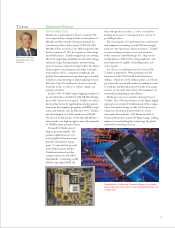Toshiba 1997 Annual Report Download - page 18
Download and view the complete annual report
Please find page 18 of the 1997 Toshiba annual report below. You can navigate through the pages in the report by either clicking on the pages listed below, or by using the keyword search tool below to find specific information within the annual report.
16.
such as S-VHS decks, units with tuners for satellite
broadcasts and decks with a three-dimensional digital
clearing function. This year, Toshiba will launch the
world’s first VCR that can record IT Vision broad-
casts. Overall, these actions are expected to raise
high-end VCRs as a share of total sales.
In the field of imaging systems, Toshiba is bolster-
ing its profile in LCD projectors and systems by
combining several projectors to generate huge “video
walls.” One of the fastest growing market sectors is
portable projectors that can be linked to PCs. In
November 1996, Toshiba began selling a SVGA-
compatible projector that generates a uniformly
bright image from corner to corner. This projector
includes a video camera to allow viewing various
materials and even moving objects on a real-time basis.
Digital Imaging Equipment
With the October 1996 inauguration of CS digital
broadcasts, Japan at last entered the age of multiple
channels. This bodes well for Toshiba’s line-up of BS
decoders and CS tuners, which are producing steady
gains in sales. In July 1996, Toshiba began selling a
CS tuner for PerfecTV! broadcasts. The tuner in-
cludes many convenient features, including a channel
memory that can quickly locate specific programs.
Household Appliances
Growth in purchases to replace aging home appli-
ances lifted demand for air conditioners, refrigera-
tors, washing machines and other widely used items
to a record high. Toshiba unveiled a series of highly
competitive products with improved functions.
Nevertheless, competitive forces exerted pressure
on prices and held down appliance sales. Toshiba
was able to post an increase in washing machine
sales, but sales of both air conditioners and refrig-
erators were lower.
Toshiba reorganized household appliance opera-
tions to respond more quickly and flexibly to changes
in this mature yet
immense market. The
new management
structure is more flat,
enabling each product
category, or business
unit, to be managed
directly by the Air
Conditioners & Appli-
ances Group. This
eliminates one layer of
management. More
importantly, this struc-
ture better facilitates the monitoring of profitability
in each business unit, and clarifies responsibilities for
achieving concrete targets.
Air conditioner shipments in Japan reached an all-
time high of 8.13 million units in the past fiscal year.
The rising practice of using separate units for each
room of a house is a significant source of growth.
Sales were especially strong for models that include
a heating capability. In December 1996, Toshiba
introduced a model that sends air upward and
downward simultaneously, thereby heating rooms
in a manner that maximizes comfort.
Difficult conditions in the Japanese refrigerator
market led to lower sales at Toshiba. One factor
impacting results was rapid growth in competitors’
introductions of units that imitate Toshiba’s mid-
mounted, drawer-type freezer design. Continuing
its tradition of innovation, Toshiba in February 1997
launched a unique refrigerator that can be switched
among freezing, chilling and three other functions.
Consumer response was encouraging, but insuffi-
cient to offset declines in other types of models.
Washing machine sales rose, backed by the
introduction of fully automatic models that conserve
water and shorten washing times.
Materials and Other Products
Electro-luminescent (EL) panels, which feature low
power consumption, benefited from rising demand
for use as backlights in mid-sized LCDs. Personal
digital assistants (PDAs) and hand-held terminals are
two major applications. In 1997, the appearance of
Windows-compatible portable PCs and PDAs with
PHS phone functions is likely to spur more growth
in the EL market. This follows an unprecedented
rate of growth in 1996. Toshiba is strengthening its
line of EL panels to cater to the broadest possible
range of requirements.
In fiscal 1996, Toshiba
shipped more air condition-
ers than in any other year in
the company’s history.
An innovative concept in refrig-
erators, this model introduced
in February 1997 has a com-
partment that can be switched
from freezing to chilling modes.
It was an immediate success.
Demand for EL
panels is rising
along with booming
sales of portable
electronic devices.
Toshiba’s EL panel
sales climbed to an
all-time high in
fiscal 1996.
























